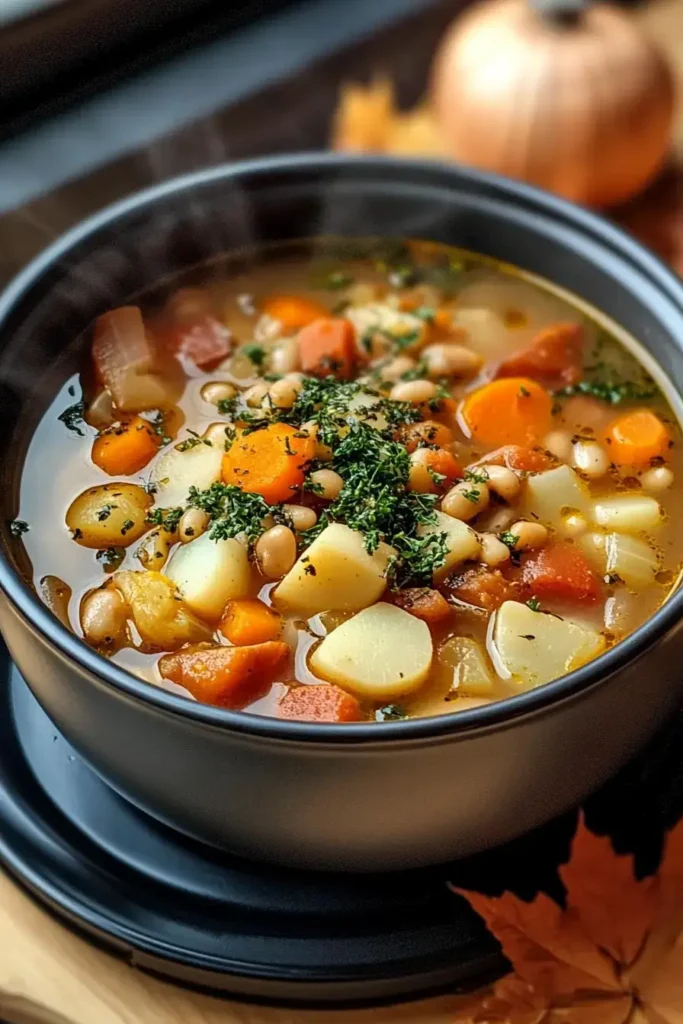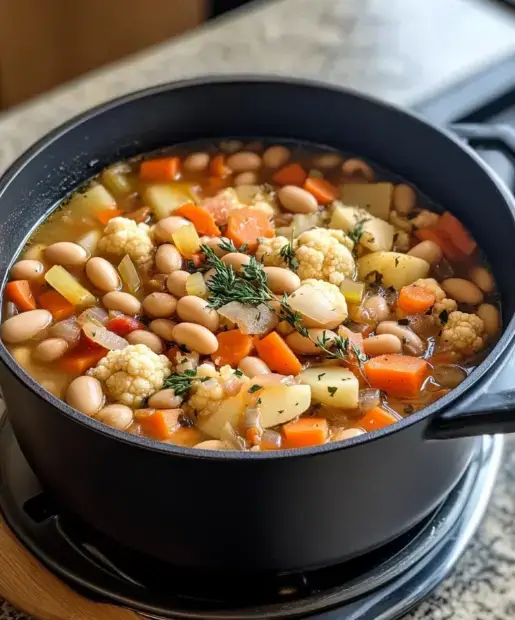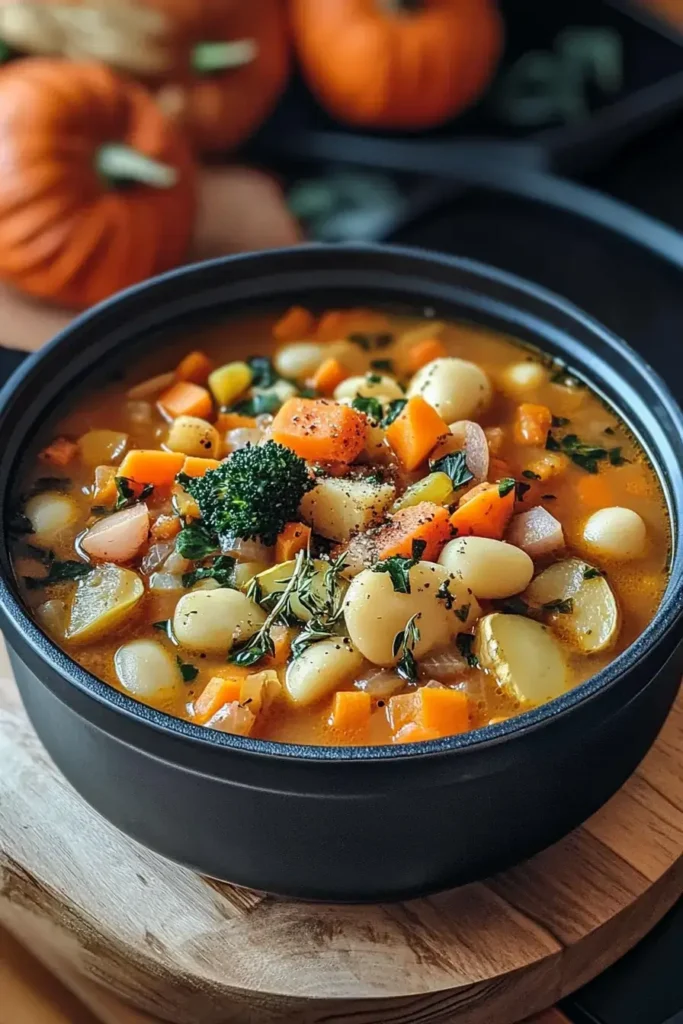Introduction
There’s something undeniably comforting about a warm bowl of rustic autumn vegetable soup. As the leaves turn golden and the air gets crisp, this hearty soup becomes the perfect meal to cozy up with. Packed with seasonal root vegetables, flavorful herbs, and nourishing broth, it’s a dish that brings warmth to your table and celebrates the bounty of fall.
Why Rustic Autumn Vegetable Soup is a Fall Favorite
Autumn is the season for earthy, comforting flavors, and this soup captures that essence perfectly. By using ingredients like butternut squash, carrots, and celery, it creates a harmony of taste and texture that feels both rustic and refined. It’s not only delicious but also highly nutritious. Root vegetables are rich in vitamins and antioxidants, making this soup a perfect way to boost your immunity during the colder months.
If you’re looking for more cozy, seasonal dishes, consider pairing this soup with Caramelized Butternut Squash with Tangy Feta and Cranberry Drizzle. The sweetness of the squash and the tang of the feta complement the hearty flavors of the soup beautifully.
Perfect Pairings for a Complete Meal
For an elevated dining experience, serve the soup with a side of crusty bread or warm, cheesy wraps. One great option is these Cheesy Garlic Chicken Wraps, which add a savory twist to your meal. Alternatively, consider adding a light appetizer like Loaded Baked Nachos with Guacamole to create a well-rounded autumn feast.
What You’ll Need
Preparing rustic autumn vegetable soup requires a few basic tools and ingredients that you likely already have in your kitchen. With the right equipment and pantry staples, making this hearty soup is a breeze. Here’s everything you’ll need to get started.
Essential Kitchen Tools
- Large Stockpot: A heavy-duty pot is crucial for evenly cooking the vegetables and simmering the soup to perfection. A stockpot with a lid is ideal for maintaining moisture and flavor during cooking.
- Sharp Knife and Cutting Board: Prepping fresh vegetables requires a good-quality knife and a sturdy cutting board to ensure precision and safety.
- Wooden Spoon: A wooden spoon helps you stir the soup without scratching the bottom of your pot, especially if it’s non-stick.
Having the right tools on hand can make the process smoother and more enjoyable. For inspiration on easy-to-make comfort foods, check out this Crockpot Steak Bites Recipe, which is another simple and delicious dish requiring minimal kitchen tools.
Key Pantry Staples
- Olive Oil: A drizzle of olive oil is essential for sautéing your vegetables and building the base flavor of the soup.
- Vegetable Broth: High-quality vegetable broth adds depth and richness to the soup, elevating the flavor of the fresh ingredients.
- Seasonings: Dried herbs like thyme, rosemary, and smoked paprika provide an aromatic and earthy flavor profile. A pinch of salt and pepper will enhance the taste of the vegetables.
Keeping these staples stocked in your kitchen allows you to whip up a comforting dish like this soup anytime. Looking for another idea? Try these Stuffed Potato Cakes: A Crispy Cheesy Delight for a delicious snack that pairs well with the soup.
Fresh Produce to Elevate Your Soup
The key to a rustic autumn vegetable soup lies in fresh, seasonal ingredients. Choose vegetables that are ripe and full of flavor to maximize the dish’s nutritional value.
- Butternut squash, carrots, and celery are classic choices for their sweetness and vibrant color.
- Onions and garlic form the aromatic base that enhances the soup’s savory taste.
- Fresh parsley or thyme makes an excellent garnish, adding a pop of green and a burst of freshness.
When combined, these ingredients create a wholesome and flavorful soup that’s sure to become a fall favorite in your household.
Ingredients
The beauty of a rustic autumn vegetable soup lies in its simplicity and the wholesome ingredients it brings together. Using fresh, seasonal produce and a handful of pantry staples, this recipe is both easy to prepare and incredibly flavorful. Here’s a detailed list of the ingredients you’ll need.
Fresh Vegetables for a Flavorful Base
- Butternut Squash (1 small, cubed): Sweet and creamy, this fall favorite is the heart of the soup. Its vibrant color and subtle sweetness add depth to the flavor.
- Carrots (3 medium, sliced): Provide a natural sweetness and a satisfying texture.
- Celery (2 stalks, diced): Adds a hint of bitterness to balance the sweetness of other vegetables.
- Onion (1 medium, diced): Forms the aromatic base of the soup, enhancing its savory notes.
- Garlic (2 cloves, minced): Infuses the broth with a robust flavor that complements the vegetables.
For more inspiration on using fresh vegetables creatively, explore this Roasted Cranberry Goat Cheese Flatbread, which showcases the best of seasonal produce.
Essential Liquids and Flavor Enhancers
- Vegetable Broth (4 cups): High-quality broth is the key to a rich and savory soup base. Opt for low-sodium options to control salt levels.
- Water (2 cups): Helps balance the flavors without overpowering the dish.
- Olive Oil (2 tbsp): Used for sautéing the vegetables, giving them a rich, caramelized flavor.
Herbs and Seasonings to Complete the Dish
- Thyme (1 tsp): Brings an earthy and aromatic touch.
- Smoked Paprika (½ tsp): Adds a subtle smoky depth to the soup.
- Salt and Pepper (to taste): Enhances the natural flavors of the vegetables.
Looking to spice things up? Try incorporating herbs from other seasonal recipes like Crack Chicken Tenders for unique flavor ideas.
Optional Garnishes
- Fresh Parsley or Thyme: Adds a burst of color and a touch of freshness.
- Sour Cream or Greek Yogurt: Provides a creamy, tangy contrast to the soup.
- Croutons or Toasted Seeds: For added crunch and texture.
By gathering these simple yet versatile ingredients, you’re well on your way to creating a wholesome, satisfying bowl of rustic autumn vegetable soup.
Instructions
Making rustic autumn vegetable soup is a straightforward process that brings out the best of seasonal ingredients. With a little prep and a few easy steps, you’ll have a comforting dish ready to enjoy. Follow the instructions below for a perfect bowl of soup.
Step 1: Prepare the Vegetables
- Wash and Chop: Begin by washing all vegetables thoroughly. Dice the onion, mince the garlic, slice the carrots, and cube the butternut squash.
- Uniform Pieces: Ensure the vegetables are cut into similar-sized pieces for even cooking.
- Optional Tip: For a deeper flavor, consider roasting the butternut squash beforehand. This adds a caramelized sweetness to the soup.
Taking the time to prepare fresh vegetables carefully ensures the base of your soup is full of flavor. For another recipe that highlights fresh ingredients, check out this Easy Cranberry Brie Thyme Phyllo Cups Recipe.
Step 2: Sauté and Build Flavor
- Heat Olive Oil: In a large stockpot, heat 2 tablespoons of olive oil over medium heat.
- Sauté Aromatics: Add diced onions and minced garlic to the pot. Sauté for 3-5 minutes until softened and fragrant.
- Add Vegetables: Stir in carrots, celery, and butternut squash. Cook for 5-7 minutes, allowing the vegetables to soften slightly and absorb the flavors of the oil and aromatics.
- Season: Sprinkle in thyme, smoked paprika, salt, and pepper. Stir well to coat the vegetables evenly with the seasoning.
This step is crucial for layering flavors. Similar techniques are used in dishes like the Cabbage Roll Casserole Recipe to create a rich, aromatic base.
Step 3: Simmer and Blend
- Add Broth and Water: Pour in the vegetable broth and water, stirring to combine.
- Simmer: Bring the mixture to a boil, then lower the heat to a simmer. Cover the pot and let the soup simmer for 25-30 minutes, until the vegetables are tender.
- Blend (Optional): To achieve a creamier texture, use an immersion blender to partially blend the soup. Alternatively, leave it chunky for a rustic feel.
- Taste and Adjust: Before serving, sample the soup and modify the seasoning to your preference.
Pair this hearty soup with a side dish like Loaded Baked Nachos with Guacamole for a complete and satisfying autumn meal.
Nutrition Score
Understanding the nutritional benefits of rustic autumn vegetable soup highlights why it’s such a great choice for a wholesome, comforting meal. Packed with fresh vegetables, this soup is not only delicious but also loaded with essential nutrients to support your health during the colder months.
Calorie Count and Macronutrients
- Calories: Approximately 120 calories per serving
- Protein: ~3 grams
- Carbohydrates: ~20 grams
- Fats: ~4 grams
- Fiber: ~5 grams
This soup is a low-calorie option perfect for those seeking a nutritious and satisfying dish. The carbohydrates come from natural vegetable sources like butternut squash and carrots, providing a slow and steady energy release.
Key Vitamins and Minerals
- Vitamin A: Found in abundance in butternut squash and carrots, vitamin A supports healthy vision and a robust immune system.
- Vitamin C: The inclusion of fresh vegetables contributes to a boost in vitamin C, which is essential for collagen production and fighting off seasonal colds.
- Potassium: Celery and squash offer potassium, which helps maintain proper muscle and nerve function.
For more recipes that prioritize health without compromising flavor, explore this Honey Garlic Shrimp Recipe, another nutrient-packed dish perfect for busy days.
Why It’s Perfect for Fall Nutrition
This soup is particularly beneficial during autumn because it’s made with seasonal ingredients that are at their peak in both flavor and nutrient density. Additionally, the fiber content promotes healthy digestion, keeping you full and energized.
Serving & Storage
A well-made rustic autumn vegetable soup deserves the right accompaniments and proper storage to maximize its flavor and shelf life. Here’s how to serve it like a pro and store leftovers efficiently for future enjoyment.
Serving Suggestions for Maximum Enjoyment
- Pair with Bread: Serve the soup alongside a warm, crusty baguette or a slice of sourdough. The bread complements the rich broth and adds a satisfying crunch.
- Garnish for Elegance: Add a sprinkle of fresh parsley, a dollop of sour cream, or a drizzle of olive oil to enhance both flavor and presentation.
- Appetizer Pairings: If you’re hosting a gathering, pair this soup with an appetizer like Roasted Cranberry Goat Cheese Flatbread. The balance of sweet and savory flavors elevates the dining experience.
For a heartier meal, consider serving it with a side of Cabbage Roll Casserole for a satisfying fall dinner.
Storage Tips to Keep It Fresh
- Refrigeration:
- Place the soup in an airtight container and refrigerate it within two hours of cooking.
- It stays fresh for up to 5 days when stored properly.
- Freezing:
- Pour the cooled soup into freezer-safe containers or bags, leaving some room for expansion.
- Mark the containers with labels and dates, then store them in the freezer for up to three months.
- Reheating:
- Thaw frozen soup in the refrigerator overnight.
- Reheat on the stovetop over medium heat, stirring occasionally, until fully warmed through.
Looking for a snack to enjoy with reheated leftovers? Try these Baked Chicken Taquitos. They pair wonderfully with the rustic flavors of the soup.
Variations
Rustic autumn vegetable soup is incredibly versatile, allowing you to customize it to suit your preferences or dietary needs. Whether you want to add protein, experiment with creamy textures, or include seasonal twists, there’s a variation for everyone.
Add Protein for a Hearty Twist
- Shredded Chicken: Add cooked, shredded chicken to the soup for a protein-packed meal. It’s a great way to use leftovers from recipes like this Best Bourbon Chicken Recipe.
- Lentils or Chickpeas: Toss in a cup of cooked lentils or canned chickpeas for a plant-based protein boost. They also add a delightful texture.
- Ground Turkey or Sausage: For a savory flavor, brown some ground turkey or sausage before adding it to the soup.
These additions transform the soup into a complete meal, perfect for chilly autumn nights.
Make It Creamy Without Dairy
- Blend Half the Soup: Use an immersion blender to partially puree the soup, creating a creamy consistency while keeping some chunks for texture.
- Coconut Milk: Add a splash of coconut milk for a dairy-free, velvety finish. It complements the earthy flavors of the vegetables beautifully.
- Greek Yogurt Swirl: For a lighter creamy touch, swirl in a spoonful of Greek yogurt just before serving.
If you enjoy creamy dishes, consider trying this Baked Cranberry Cream Cheese Dip for a festive appetizer alongside the soup.
Seasonal Additions for Extra Flavor
- Sweet Potatoes: Swap butternut squash for sweet potatoes or include both for added sweetness and a boost in fiber.
- Kale or Spinach: Stir in fresh kale or spinach during the last five minutes of cooking for a pop of color and added nutrients.
- Roasted Vegetables: Roasting vegetables like parsnips or zucchini before adding them to the soup enhances their natural sweetness.
For more creative vegetable dishes, check out this recipe for Stuffed Potato Cakes. It’s another way to explore seasonal flavors.

FAQs
Answering common questions about rustic autumn vegetable soup helps ensure that your cooking experience is seamless and that you achieve the best results. Here are some frequently asked questions along with their answers.
What Can You Add to Vegetable Soup to Give It More Flavor?
Vegetable soup can sometimes lack depth, but there are many ways to enhance its flavor:
- Herbs and Spices: Fresh herbs like thyme, rosemary, and parsley can add an aromatic boost. A pinch of smoked paprika or cumin brings a smoky or earthy undertone.
- Acidic Ingredients: A splash of lemon juice, balsamic vinegar, or a touch of tomato paste brightens the overall flavor.
- Cheese Rinds: Adding a Parmesan rind during simmering infuses the soup with a savory, umami-rich taste.
For additional ideas on flavor enhancements, check out the Crack Chicken Tenders Recipe, which uses seasoning creatively for a bold taste.
Why Does My Vegetable Soup Have No Taste?
If your soup feels bland, it might be due to under-seasoning or overcooking. Here’s how to fix it:
- Salt Wisely: Season the soup at multiple stages—while sautéing vegetables, during simmering, and after tasting before serving.
- Layer Flavors: Build flavor by sautéing onions and garlic first, then adding vegetables and spices gradually.
- Don’t Overwater: Using too much liquid dilutes the flavors. Stick to the recommended broth-to-water ratio.
For a recipe with bold and balanced flavors, try this Caramelized Butternut Squash with Tangy Feta and Cranberry Drizzle.
What Makes a Bowl of Soup More Flavorful?
The secret to a flavorful soup lies in the technique and quality of ingredients:
- Use Fresh Vegetables: Opt for seasonal produce at its peak flavor, such as butternut squash and carrots during autumn.
- Roast Vegetables: Roasting vegetables before adding them to the soup intensifies their natural sweetness and depth.
- Simmer Slowly: Allowing the soup to simmer gently for at least 30 minutes lets the flavors meld beautifully.
If you enjoy hearty, flavorful dishes, check out the Cabbage Roll Casserole Recipe for another comforting meal idea.
Can I Eat Vegetable Soup After 7 Days?
Storing soup for too long can compromise its safety and flavor:
- Refrigerated Soup: It’s best to consume vegetable soup within 5 days when stored properly in an airtight container.
- Frozen Soup: For extended storage, freeze the soup. It can last up to 3 months in the freezer without losing quality.
- Check for Freshness: Before consuming, check for any signs of spoilage, such as an off smell or discoloration.
For ideas on dishes that reheat well, explore this Loaded Baked Nachos with Guacamole, a versatile appetizer that pairs well with leftovers.


